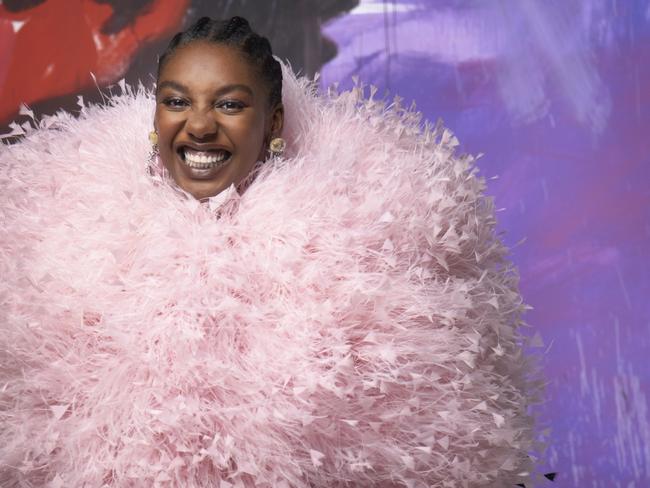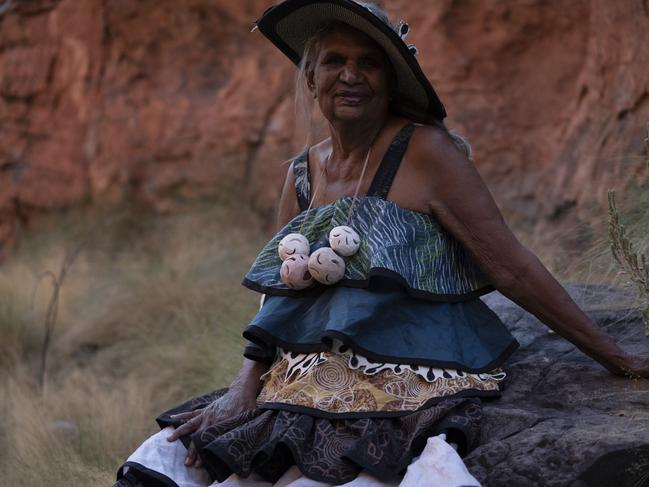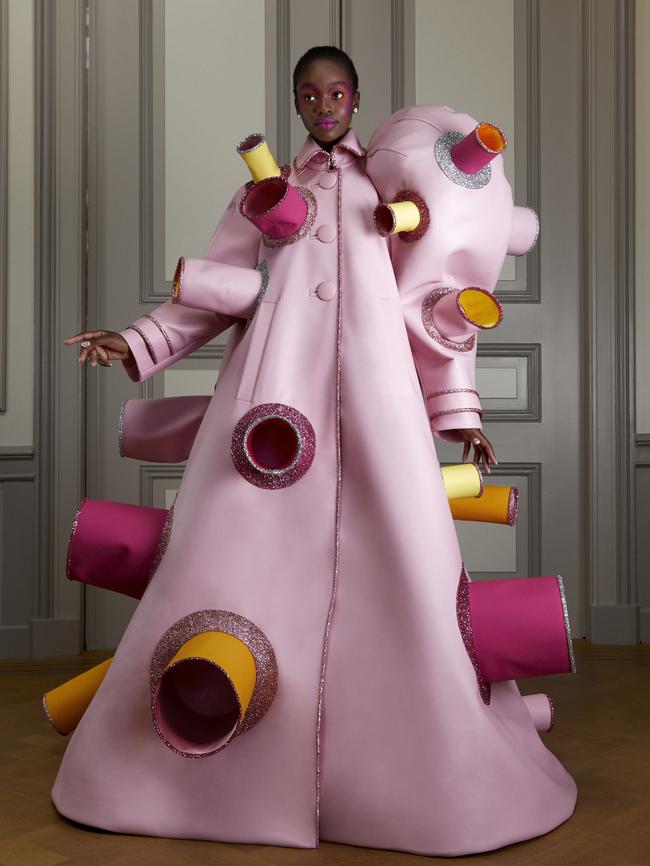Fashion in 2020: Hoodies, face masks and the rise of diversity
Or the year that changed everything? From hoodies to face masks and the rise of diversity, 2020 was a year in fashion like no other.

As the autumn/winter fashion weeks in Milan and Paris finished in early March, the wave of COVID-19 quickly swept through in their wake. Fashion watchers flipped from analysing trends (leather fringing, anyone?) to asking, “Is fashion even relevant in a pandemic?”
Hoodies and track pants became the official uniform of 2020 (soon accessorised with face masks), bringing a focus on comfort and cocooning as cities went into lockdown and lounge rooms doubled as offices.
It was also a moment for the industry to stop and take stock — while also trying to remain afloat. For consumers, it was a time to decide what was really important, and whether fashion truly reflected their values. Here, some highlights of this, yes, “unprecedented” year in fashion.
True colours
Diversity in fashion has been a hot topic for years — this year it finally gained the momentum it needed to stop it from embracing tokenism and to finally make real progress.
The death of Minneapolis man George Floyd in May while in police custody recharged the Black Lives Matter movement, which put the topic front and centre of global headlines. From film to fashion, business to politics, industries and companies the world over had to address systemic racism within.
In the fashion industry, diversity and inclusion meant a focus on representation of all kinds — including age, size, ability and gender.
Soon, campaigns, advertising, shoots and the few catwalks that happened this year were using a wider range of models to address this.
Brands are increasingly offering a wider range of sizes and expanding the range of colours under the “nude” banner, in both fashion and beauty. Rihanna’s Fenty line was a leader across both of these, and Kim Kardashian’s new Skims range of underpinnings has also gained kudos for its inclusivity of skin tones and sizes.
Industry bodies such as the Australian Fashion Council, Council of Fashion Designers of America and the British Fashion Council have all cited inclusivity as part of their ongoing remits, while companies and conglomerates including Kering and LVMH have committees and roles to make sure that they are moving forward on this issue.

Edwina McCann, editor-in-chief of Vogue Australia says that we are in the “upheaval phase”, but there is a long way to go — and real change has to take place at all levels of the industry.
“Much like we haven’t reached gender parity in pay, there is a lot of inequity that exists structurally - and that means it will take much more than one year unfortunately to dismantle,” said McCann.
“The solution requires a sustained concerted effort. Inclusivity outwardly means very little if inclusivity isn’t strived for behind the scenes. A light has been switched on, and the extent of the issue has been illuminated — and no one can unsee that.”
Hero hoodies
Frontline workers were the true heroes of 2020; and as we retreated into our homes and bedrooms to live and work and work out, hoodies soon became our wardrobe heroes.
Who could have anticipated in January that by June, fashion writers the world over would be extolling the virtues of sweaters and track pants, ugg boots and slippers? Who needed that striped lurex jumpsuit now? Cocooning was what the style doctor ordered as people the world over tried to make sense of their new world order: stay home, stay safe.

Activewear also skyrocketed as Pilates and yoga classes went online and some people’s only activity during lockdowns was a run or walk in the open. And the sales reflected this.
In October, David Jones general manager womenswear told The Australian: “Activewear, loungewear (including hoodies and tracksuits) and slippers have been some of the standout categories, and that continues even as the states have opened up.”
Sydney activewear label P.E Nation was another that benefited from the shift. Co-founder Pip Edwards said: “There is no way you could keep a hoodie, a sweat or a track pant on the shelf. It’s like they’ve never worn tracksuits in their life.”

Masked avengers
If hoodies and tracksuits were the official uniform of 2020, then the face mask became the accessory of the year.
While the disposable surgical styles in white and blue were ubiquitous, those looking for a more sustainable and fashionable option soon turned to reusable fabric masks.
For some brands, they became a way to use up leftover fabrics and keep them from landfill; for consumers they could be a way to personalise an outfit or show some personality.
In some places — America, we’re looking at you — they became politically divisive. For most people, they were simply recognised as the easiest and most effective way of doing your bit to help stop the spread of COVID-19. Not too much to ask, is it?
Zoom dressing
While few of us had even heard of Zoom or bothered with video conferencing platforms before the pandemic, the trend of “Zoom dressing” soon became a by-product of “working from home” — or should I say, #WFH.
The fashion equivalent of the mullet, this business on top, trackies on the bottom approach was a mix of comfort and near-professionalism.

Dressing “from the waist up” was soon a concept accepted by anyone unable to go to the office and have human interaction with others outside their home.
Men added business shirts to their running shorts, while women could wear their favourite blouse with leggings. As long as you weren’t required to suddenly stand up during your Zoom call, who would ever know that you were still in your pyjama bottoms at 3pm?
Indigenous fashion
Further to the increase in diversity seen in fashion this year, closer to home it provided the perfect backdrop for our own Indigenous fashion industry to gain some long-overdue recognition.
The inaugural National Indigenous Fashion Awards were held in August, born of the Darwin Aboriginal Art Fair. The awards highlighted the work of a range of designers and artists from across the country, from traditional textiles and printing to contemporary street style.

Surely one of the images of the year was Peggy Griffiths modelling her award-winning Legacy dress, hand block-printed with members of her family.
The dress was acquired by the Bendigo Art Gallery and also features in its exhibition Piinpi: Contemporary Indigenous Fashion, which opened, finally, in October after pandemic postponements. Again, the exhibition blends the traditional and the modern, and is the first major exhibition of Indigenous fashion in Australia.
Virtual catwalks
With the world in the grip of the pandemic, and restrictions and social distancing the new normal, the fashion industry had to try new ways of presenting collections, and the digital had to replace the physical. In some cases, an alarming new word - “phygital” - emerged to describe shows that blended the physical and the digital.
Catwalk shows were replaced with short films or virtual catwalks in varying degrees of success; some simply held catwalk shows without an audience and videoed or livestreamed the result.
The most successful managed to convey a sense of place or a mood that at least transported those watching on their laptops to somewhere more exotic, even just a change of mood. It also meant that the catwalk became more democratic – anyone could have a front-row seat, not just those who work in the industry.
Anything that translated to beautiful imagery on Instagram was a winner. Highlights of the year included Jacquemus’s scenic wheatfield show outside Paris; Halpern’s joyous dress-ups with frontline workers; Thom Browne’s Lunar Olympics show; Viktor & Rolf’s pointed take on pandemic fashion in a traditional salon style; and shoe brand Roger Vivier’s interactive Hotel Vivier Cinematheque, a kind of “choose your own adventure” short film starring French actress Isabelle Huppert.
As with so many other things this year, the pandemic has accelerated change in the way we present new collections — here’s hoping we don’t just revert to the same old traditions once things get back to normal.
Industry upheaval
With China the first country to be affected by COVID-19, factory closures in the country soon started a ripple effect that would affect fashion supply chains throughout the world. It quickly forced a deeper introspection for this “broken” industry, asking: is it time to rethink the fashion model?
The issues are legion: outdated fashion presentation schedules, overly complex supply chains and delivery schedules, the ever-increasing pace of fashion, over-production and wastage, over-consumption of fast fashion, disposablility of fashion, environmental damage at all levels of the fashion cycle, and the constant markdown cycle including event sales such as Black Friday — to name a few.
Italian designer Giorgio Armani was the first to speak out, in April, in an open letter to Women’s Wear Daily.
“The moment we are going through is turbulent, but it also offers us the unique opportunity to fix what is wrong, to regain a more human dimension,” he wrote, also calling the industry model “absurd”, especially in relation to seasonal collections being out of sync with the actual seasons.

In May, Belgian designer Dries Van Noten penned another open letter, subsequently signed by more than 500 brands and retailers, suggesting that this year’s upheaval “presents an opportunity for a fundamental and welcome change that will simplify our businesses, making them more environmentally and socially sustainable and ultimately align them more closely with customers’ needs”.
Then Business of Fashion launched Rewiring Fashion, another initiative to address these issues; this month the two groups announced they will now work together.
But come the end of the year, how much has really changed? After months of digital shows and inventive online storytelling, the catwalks of Milan and Paris were once again open (if socially distanced) in September and October to show the Spring 2021 collections; last month’s Black Friday sales were the biggest ever. Granted it’s going to take years to effect real change, but here’s hoping the momentum doesn’t stop now.
Online shopping
Online shopping has been growing incrementally in recent years, but this year it got a boost thanks to COVID-19.
With retail closed during lockdowns, people had no other option but to buy what they wanted online — and Australia was no exception.
In 2019, only 9 per cent of sales were online, up from less than 5 per cent in 2010; this year it is expected to be up another 6.3 per cent, according to IBISWorld analysts. Last month, Paul Zahra, chief executive of the Australian Retailers Association, told The Australian that “over one million households have shopped online for the first time since March”.
Vintage appeal
Sustainability got a foot up this year thanks to people embracing “conscious consuming” — using those hard-earned dollars for positive impact.
Within that, vintage and second-hand fashion saw a boost especially among environmentally aware younger consumers, for whom buying someone else’s cast-offs finally shrugged off any negative connotations. After all, items are cheaper and not being sent to landfill: win-win.
“We have seen an increased demand for vintage pieces this year,” Sophie Hersan, co-founder of luxury resale site Vestiaire Collective told The Australian.

In a report with Boston Consulting Group this year, 70 per cent of Vestiaire’s respondents said that they were shopping with sustainability in mind — up 8 per cent on two years ago.
“Vintage is of course more affordable, but aside from this price aspiration it is a more sustainable option.”
The company said that in Australia alone, growth in vintage fashion was up 59 per cent.
Vestiaire was not alone in experiencing this rise in interest. US resale site ThredUp anticipates the online secondhand market will grow 69 per cent by 2021.
In October, Levi’s launched Levi’s Secondhand in the US, an online portal for its pre-loved denim, while another fashion resale site TheRealReal launched a joint initiative with Gucci to resell its items. And whoever would have thought there was a market for a new magazine — Display Copy — “that doesn’t feature a single new fashion item”, according to its founder and editor-in-chief, Brynn Heminway.
“Sustainability is the present and the future,” added Hersan. “We were already starting the transition in the past few years, but the pandemic has accelerated it and now people claim that it’s urgent, that there’s no comeback.”
